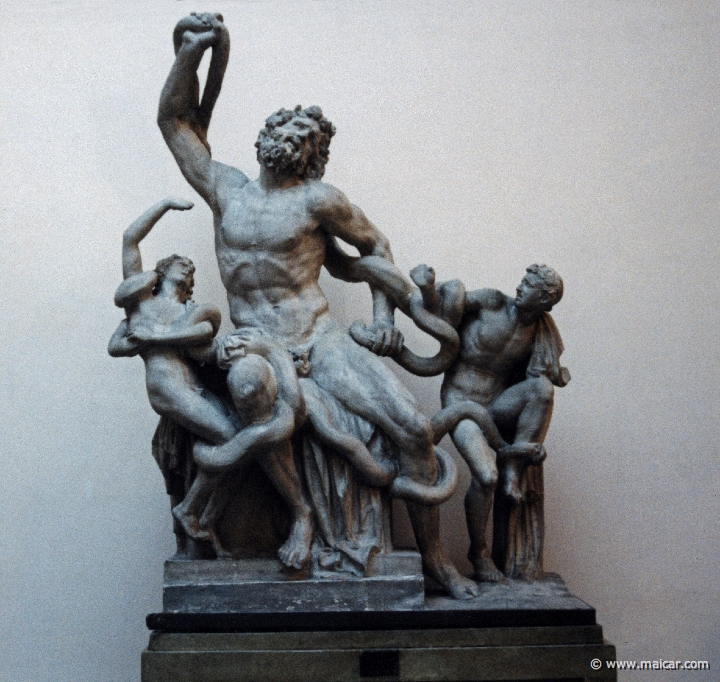|

|
6920: Laocoon and his sons, c. 25 BC, Rhodes. Copy at Konstakademin, Stockholm.
|
|
The seer Laocoon 2 warned the Trojans against the WOODEN HORSE (as Cassandra also did), telling them not bring that piece of art into the city. And because he threw his spear against it, a deity sent from neighboring islands, snakes to kill his sons; and while trying to help them, he was blinded or even killed.
Fateful device
Troy was taken in the
tenth year of the war, not mainly by force but
through the stratagem of the WOODEN HORSE,
conceived by Odysseus: The Achaeans let the architect Epeius 2 fall timber on Mount Ida and construct a WOODEN HORSE with a
hollow interior and an opening in the side. Then,
following Odysseus'
advice, they introduced the best warriors into that
dangerous device, and after appointing Odysseus their leader,
they engraved on the horse a treacherous
inscription:
"For their
return home, the Achaeans dedicate this
thank-offering to Athena." (Apollodorus, Library "Epitome" 5.15).
This is how the Achaeans feigned retreat; and
the next day the Trojans, finding the enemy camp
deserted and believing that the Achaeans had fled,
dragged the horse to the citadel.
Cassandra's warning
Having stationed it beside the king's palace,
they deliberated what they should do, whether to
hurl it down from the rocks, to burn it, or to let
it stand as a great offering to the gods. It was
then that the god-maddened seeress Cassandra declared,
with her frenzied voice, that there was an armed
force hidden inside the WOODEN HORSE,
warning the others thus:
"O wretched
men! why rage you possessed, dragging this
unfriendly horse, hasting to your last night and
the end of the war and the sleep that knows no
waking?" (Cassandra to the
Trojans. Tryphiodorus, The
Taking of Ilios 375).
Yet no one was to believe Cassandra; for she had
been cursed by the same god who gave her the gift
of prophecy in exchange for a promise she never
fulfilled. So Apollo (for
this one was the god), avenging the broken promise,
caused her prophecies not to be believed.
Laocoon 2's short appearance
It is now that the seer Laocoon 2, priest of Apollo, comes into the
story for the first time (for nothing is told about
his childhood or youth), confirming Cassandra and
exhorting the Trojans to burn the WOODEN HORSE:
"Is it thus
you know Odysseus? Trojans, trust not the horse.
Whatever it be, I fear the Greeks, even when
bringing gifts." (Laocoon 2 to the Trojans. Virgil, Aeneid 2.48).
Some say that Laocoon 2 even threw his spear against the horse.
Athena stays Laocoon 2
But others say that the Trojans were about to
obey him when Athena shook the foundations of the earth at his feet as a warning; and since he did not cease to exhort the Trojans, the goddess, stabbing his eyeballs with anguish, robbed him of his sight. And when he nevertheless persisted, she sent two serpents or dragons from Calydna against the sons of the seer, chaining their feet as all others, except their father, escaped. This is how, some say, Laocoon 2's sons died, and their father was blinded.
Apollo sent the snakes
Yet others affirm that it was Apollo who sent the two serpents swimming through the sea from the neighboring islands to devour the sons of Laocoon 2, and that as he hurried, weapon in hand, to help his sons, he was killed by the monsters, which, gliding away, disappeared into a shrine.
The force of adversity
Now, if the snakes had not come, or if Laocoon 2 had succeeded in defeating them, he had been deemed to be a very wise man, who knew the secret of the WOODEN HORSE without
opening it. But since adverse circumstances
overwhelmed him, many argued that the man had got
what he deserved, and that the horse should be
brought to the shrine of Athena (the same goddess who was misleading them), which they did, thus laying open the heart of the city. For the majority among the Trojans, being no different from any other majority of men, preferred success before good sense, and seeing how Laocoon 2 had been destroyed, they refused to imagine that a man, though defeated, could still be in possession of the truth. But the majority must prevail, sometimes against
all sense; and so, since most Trojans were in
favor of sparing the wonderful horse, they all
ended, as a result, sleeping with the enemy within
the walls. The majority never woke up, being slain
in their beds.
Additional note
Now, why would Apollo sent the monsters to destroy his priest? According to Frazer, Servius (himself based on Euphorion) says that Laocoon 2 had incurred the wrath of the god by sleeping with his wife in the presence of the deity's image; and Frazer adds that Tzetzes affirms that Laocoon 2's son died in the temple of the Thymbraean Apollo,
the scene of the sacrilege thus becoming the scene
of the punishment.
Concerning the famous statue (see copy at top of page). says Frazer:
"That group, the work of three Rhodian sculptors, graced the palace of the emperor Titus in the time of Pliny, who declared that it was to be preferred to any other work either of sculpture or painting." (Pliny, Nat.
Hist. xxxvi.37).
Another with identical name
Laocoon 1 is the same as Lacoon, one of the ARGONAUTS. |